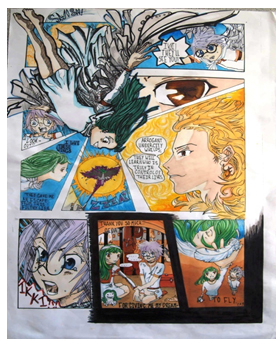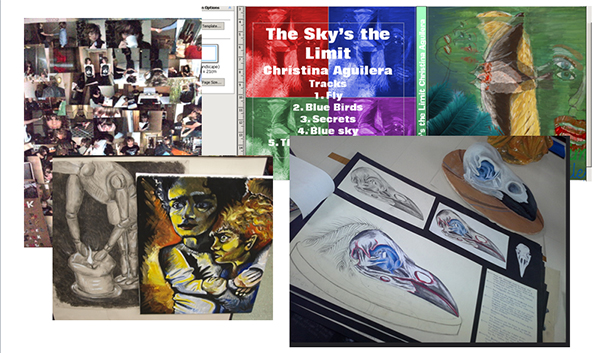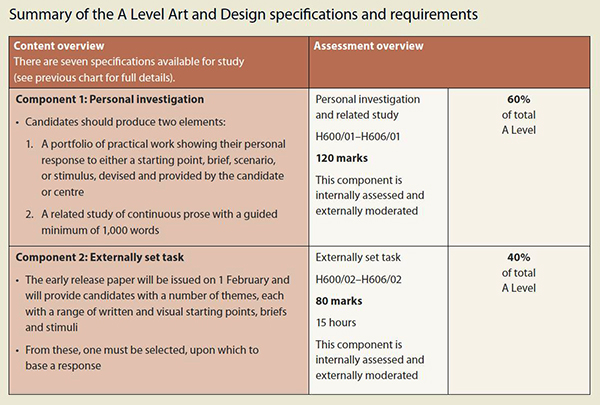Art
"Art teaches nothing, except the significance of life."
Henry Miller
"Study Art and Design..."
- For self-expression.
- For imaginative thinking and problem-solving.
- For visual literacy.
- For skill and dexterity.
- For analytical and research skills.
- For increased perception and aesthetic awareness.
- For appreciation and understanding of your own and others' cultures.
- For wellbeing.
- For jobs.
Visit the Art Department's microsite
Extracurricular
We have a photography club and an art club during lunchtime in KS3. We encourage all students to use the art rooms whenever they are available - which is most lunchtimes. We have Sixth Form mentors who help run clubs or assist with work. At GCSE and A Level we run numerous trips to galleries in London and abroad.
Key Stage 3
Aims and rationale:
- To provide a learning experience which supports a lifelong interest in visual and tactile expression, both through the student’s own creative journey and through the appreciation of the work of others.
- To provide a sound grounding in art, craft and design, covering core skills and concepts that equip students to be assured in visual literacy for their education at KS4 and beyond, in Art and in the wider curriculum.
- To ensure access to a range of media, formats and disciplines, both traditional and digital.
- To provide learning opportunities that promote dexterity and physical/spatial problem-solving, particularly by ensuring access to 3D formats and materials.
- To equip students with the vocabulary, both visual and language-based, to critically evaluate their own and others' work.
- To inspire knowledge and appreciation of the role of art and design in the creation of culture.
- To encourage inclusivity through access to a wide range of art, craft and design heritage, reflecting an inclusive range of time, belief, gender and ethnicity, and drawn from both Western and non-Western cultures.
- To realise the significant financial contribution of art, craft and design industries to the UK economy whilst raising awareness of career choices.
Year 7:
At HGS, students will start their studies of visual elements in two-dimensional studies (painting, print-making, collage) within flat, decorative formats, using symmetry as a compositional device. In their three-dimensional studies (ceramics, sculpture), they will learn about basic clay construction techniques.
Year 8:
Students will start to explore visual language through more rhythmic, asymmetric arrangements of elements. In ceramics studies, they will learn sophisticated hand-building techniques such as coiling.
Year 9:
Year 9 begins with students investigating spatial depiction in both two- and three-dimensional studies. They learn about perspective and tackle more complex descriptions of form in space.
Key Stage 4
GCSE ART AND DESIGN
Aims and rationale:
This course is about having an adventurous and enquiring approach to art and design, and developing the skills to express it. Students will gain an understanding of past and contemporary art and design, and produce personal responses, embracing a range of ideas. They will acquire a working knowledge of the materials, practices and technology of art and design by following a course that teaches fine art, graphic design, photography and 3D design. They then select a discipline(s) to specialise in later in Year 10 and Year 11.
Our GCSE Art and Design course is intended to enrich students’ cultural and creative understanding and foster the capacity for a lifelong engagement with art and design. It also equips students with the basis of a future career interest/pathway. It will support progression into further study of art and design, and a job where it is useful to have had experience of art, craft and design. Such jobs are numerous in fields including advertising, marketing, design (particularly Fashion and Graphics), architecture and media.
What is the course?
OCR Art and Design (9-1) - J170-J176
Coursework portfolio – 60%

Three small projects, starting in Year 10, which together make up a portfolio of work. You will be given a very open-ended theme – previous examples are ‘Underneath and Overhead’ and ‘Growth’. Initially, you will be guided closely by your teacher as to how to interpret the themes and what materials to use, but midway through Year 10, you can focus on the media and subjects you want.
Set task – 40%
The exam paper is given to you in January of Year 11, and you have until April to prepare for a ten-hour ‘test’, where you can make a piece of art in any media you wish. Some students paint, others work on computers, etc. The titles are varied and open to wide interpretation.
What I can do in GCSE Art and Design
PAINTING, SCULPTURE, PHOTOGRAPHY, CERAMICS, GRAPHICS, TEXTILES, DIGITAL, DRAWING, COLLAGE.
We try to help you work with as many materials as we can, so that you find the processes that suit you and your strengths and interests. You are making art that is personal and expressive, judged on quality of composition, drawing, control of media and reference to artists.

Key Stage 5
ART AND DESIGN AT A LEVEL
Aims and rationale:
This course is intended to enrich students’ cultural and creative understanding and foster the capacity for a lifelong engagement with art and design. It also equips students with the basis of a future career interest/pathway. It will support progression into further study of art and design, and a job where it is useful to have experience of art, craft and design. Such jobs are numerous in fields including advertising, marketing, design (particularly Fashion and Graphics), architecture and media.
At A Level, we offer the chance to follow a general foundation course before opting for a specialist pathway in either Fine Art, Photography, Graphics or Critical and Contextual Studies. Not only does this assist students in identifying areas of strength, but it also helps when applying for a course beyond A Level, which requires a variety of work. Students are only assessed on the work done in their specialist area.
OCR Art and Design - H600 -H606
These practical courses will enable you to develop the creative and intellectual skills for imaginative growth, and to access the vast array of further studies and careers in art and design.
It is an excellent complement to many other areas of study, as it teaches you to be analytical, to solve problems creatively and to gain a cultural awareness. You will explore relevant images, artefacts and resources relating to Fine Art/Photography and may use traditional methods and/or digital techniques to produce work. You will be expected to demonstrate specialisation in particular materials, media or processes. Drawing/recording skills should be understood and developed as ways of communicating intentions, ideas and emotions. There is an important focus on your recording through using drawing or other appropriate visual forms.

What is the course?
FINE ART
In Year 12 you will follow a course from September to March where you are learning and building skills free of assessment. The focus will be on how to draw and photograph, and exploration through printmaking, painting, sculpture, graphic media (ink, pencil, etc.) and digital processes. In addition, you might explore textiles. In February, you will be issued with an exam paper by OCR with titles you can interpret. You will present a body of work in media of your choice, exploring a theme of your choice to a conclusion in a timed exam. This unit is assessed.
PHOTOGRAPHY
Same structure as above, but the focus will be on learning analogue photography and darkroom skills, digital photography and Photoshop software.
Both courses require you to continually engage with the work of other artists, designers and craftspeople, and learn how to evidence their influence on your own work’s development (AO1 – Develop). Both courses require you to explore and experiment with materials and ideas, refining those ideas into compositions (AO2 – Experiment). Both courses require you to record from your own experience and the Fine Art course requires you to draw (AO3 - Record). For the assessed unit, you must evidence those three objectives to gain marks – along with AO4 – Present, which is the requirement to produce a unified folder and a final piece/s of work as resolution of your project.
Teaching staff
Sarah Wallace: Head of Department. Fine Art specialist (painting and printmaking)
Nicola Collins: Teacher. Painting and ceramics specialist
Ruth Cooper: Teacher / Assistant Headteacher. Fine Art (sculpture) and English specialist
Eleanor de Wild: Teacher. Art & Design and English specialist
Tom Pateman: Teacher. Fine Art specialist (painting and sculpture)
Zoe Roberts: Technician. Theatre Design specialist (wig and hair)
